Article
Anacortes: Washington State's Painted Lady
Author(s):
Bill Mitchell is an artist in Anacortes, Wash., the traditional end of the road to catch the ferry to the San Juan Islands. His prolific paintings, which appear on most of the exterior walls in town, are nothing short of astonishing.
Photography by the authors.
Bill Mitchell is an artist in Anacortes, Wash., the traditional end of the road to catch the ferry to the San Juan Islands. He’s painted more than 123 numbered murals on the walls of this little town, so named in 1879 by Amos Bowman, the first postmaster, after his wife, Anne Cortez.
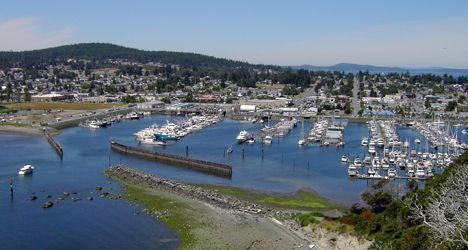
His prolific paintings are nothing short of astonishing. Mitchell had an accident in 1971 that left him quadriplegic. He was driving his 1965 MGB “too fast, as usual,” he says, and lost control, skidded for 500 feet and then rolled three times. “I never lost consciousness,” Mitchell says, “so I was able to talk to the police when they arrived and they were there in a minute. I said to them, ‘You didn’t take long to get here!’ and they replied, ‘We were right behind you. We were chasing you!’”

Mitchell has no movement in his fingers, but can move his shoulders, elbows and wrists a little, so he has learned to paint using variations in those three joints. “My body has become a great drafting machine,” he says. Mitchell gets around town without complaint in his faithful 1954 Autoette electric cart and wheelchair, and has been called the most colorful man in Anacortes. Some of that may go back to his life in the early pop-culture 1970s as a former “underground cartoonist” for the North West Passage, which is today the oldest surviving underground newspaper in the U.S.
Mitchell started his mural project in 1984 with the idea he would show 100 years of his town’s history. He was declared the 2010 Patron of the Arts by the Anacortes Festival as tribute to the impact on the arts made by what it called “his grit, tenacity and talent.” Visitors hear he’s making 2011 his last year. As if sensing that, he has hurried his pace and has created 20 cutouts in the last 13 months.
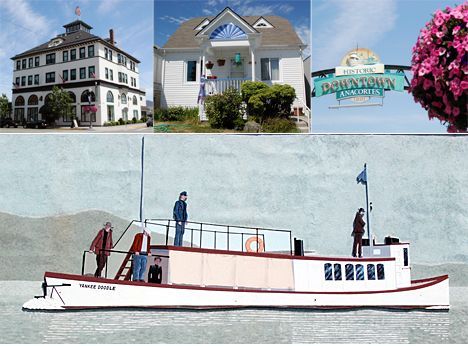
Mitchell who has lived in this neat example of Small Town America all his life couldn’t have chosen a prettier, more patriotic town as his canvas. Red, white and blue flowers cascade out of pots on the sidewalks, and even fire hydrants show their patriotism with their stars and stripes décor. Hanging baskets spill flowers everywhere. People smile in the streets and the volunteers in the tourist office on the main street are particularly amiable, as if Anacortes had been designed by Walt Disney and they had to do their bit to make it all work.
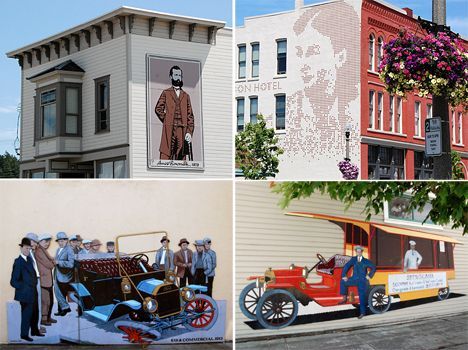
As you enter the downtown area of the Anacortes mural project, heading north on Commercial Avenue, you find Mitchell’s mural of the Yankee Doodle, the passenger ferry that connected the town with Bellingham and San Juan Island in 1911. (It’s easy to find the town’s murals with the street map provided free by the chamber of commerce office. Pick up a MacGregor’s Anacortes Visitors’ Guide or an Old Town Graphics map.) Parking is plentiful at the entrance to downtown, and Anacortes is absolutely flat, perfect for walkers and cyclists, and strollers -- and wheelchairs.

Among the many murals in town is one that depicts the first car wreck on Commercial Avenue. The automobile was a 1913 Ford and the damage was extensive (two broken wheels, a twisted axle and a wrecked fender with a bill of $34.80).
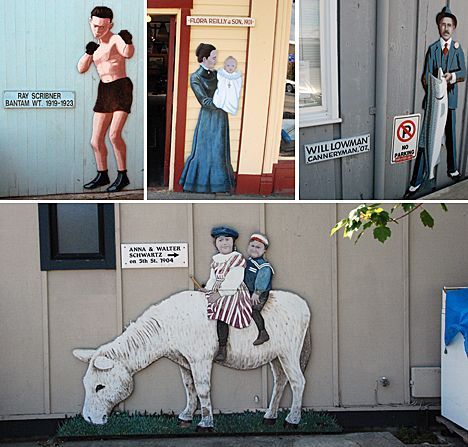
Another mural, one of a 19824 Dodge truck includes two people, Paul and Nicola Luvera. “Who are those people?” we wonder. Were they real? Did they live?
Indeed they did. Nicola was the grandfather, the Italian immigrant who came to America in 1902 laying rail for the Canadian Pacific Railroad, then later working as a coal miner in Alberta, until he had saved enough to bring his family over. Paul, his son, died in 1990 at the age of 92 and his son, Paul N. Luvera Jr., a prominent Seattle plaintiff’s attorney, wrote a most moving account of his family on his blog on the anniversary of his father’s death.
There are other worthy former residents of Anacortes honored on its walls, from Will Lowman, a cannery owner way back in 1907 and Ray Scribner, a local butcher and bantam-weight boxer who fought 1919-1923, to baby Joe Reilly Jr. with his mother Flora Knapp Reilly in 1901. Some of the children portrayed in Mitchell murals were his own own grandparents.
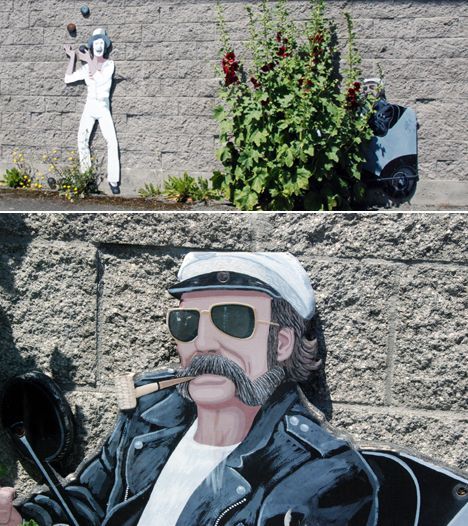
We can’t talk about the people of Anacortes without coming back to Mitchell. Everyone in town knows who he is, but he’s reticent and hard to find. Even his self-portrait is elusive — we finally found it hiding behind a bush that had to be pulled down to show his face, although the anonymous juggler beyond the painting was fully exposed.
Mitchell’s first painting was Fred White and his 1893 Safety Bike, which he painted in 1984 outside the Marine Hardware Store. We imagine it would be a great honor to be depicted in the last mural he’d paint next year, the final one of his celebrated Mural Project.
The murals were painted from old photographs. “It’s very grass roots,“ Mitchell says. “The people may be long, long dead but are well remembered.” In the pictures he looks for a full body shot with the subject standing outdoors. Then he goes into what he calls “his Frankenstein work: cutting off arms, shortening legs, creating a mirror image, even switching heads on a body.” He next makes an acetate and projects the image on to ¾ inch plywood that has a moderate density overlay because that surface is smooth.
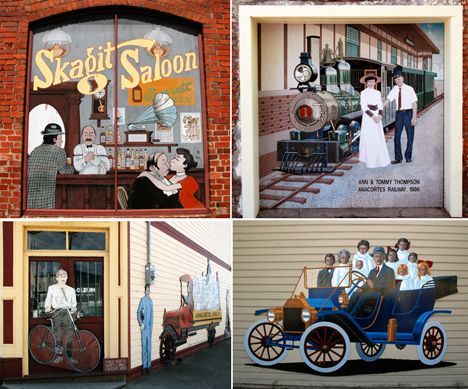
The subjects painted are maritime transportation, the fishing industry, early automobiles, music, entertainment and leisure activities. The models from old photographs can be historical events, teaching experiences, crusty curmudgeons, favorite children, worthy locals, pretty girls. A favorite mural includes the view in the window of the Skagit Saloon, a bar in the entire city block that burned down in 1902. There were many lumber mills in the town at that time and sparks from the equipment could easily set fire to the piles of sawdust.
The people shown were real. Tommy Thompson, for example, was a retired engineer who had a lifetime fascination with trains. He ran his hand-built narrow gauge railway train for 13 years along seven blocks of downtown until he died in 1999. He created everything himself: laid the rails, forged the brass bell, sewed the velvet seat cushions, molded the interiors, painted the gold leaf lettering. “He built his Anacortes Railway piece by piece over the years, working on it nights and weekends, and recording more than 1,400 hours on one car alone,” said his wife of 43 years, Anna Thompson. “The mayor’s wife once said he put more smiles on children’s faces than anyone she knew!” The train is gone now but the painting surely remains to celebrate the Thompsons.
Not only were the people real, but some of the cutouts have secrets. Mitchell is a neat worker and has lots of patience, so he sometimes adds messages to his art. The 1921 Model T, for example, has the history of that model written on its tires and a portrait of Andrew Carnegie has the life history of the “The Man of Steel” written on his lapel and inner leg seam. “Sixty words and they took me 65 minutes to write,” says Mitchell.
The Andersons, who live in San Diego, are the resident travel & cruise columnists for Physician's Money Digest. Nancy is a former nursing educator, Eric a retired MD. The one-time president of the New Hampshire Academy of Family Practice, Eric is the only physician in the American Society of Travel Writers. He has also written five books, the last called The Man Who Cried Orange: Stories from a Doctor's Life.




